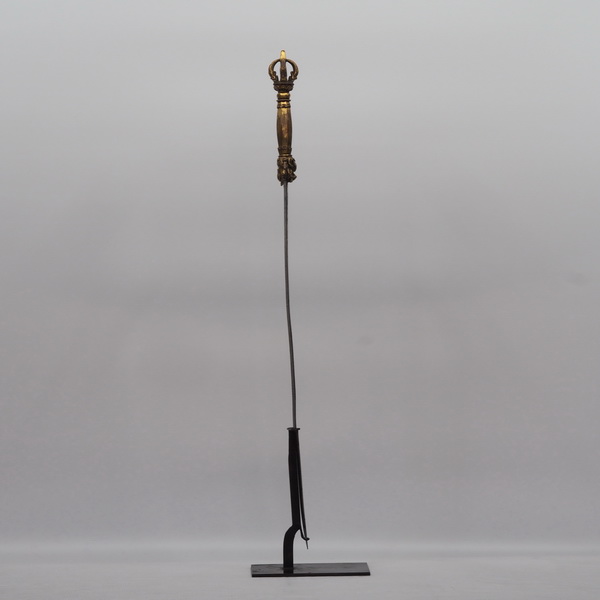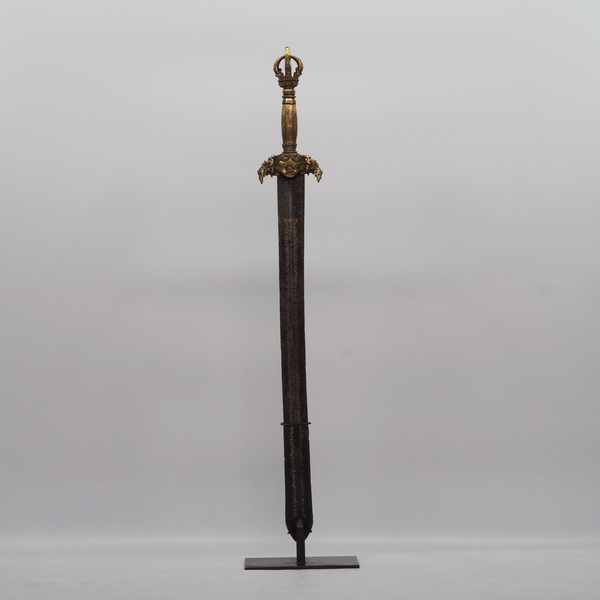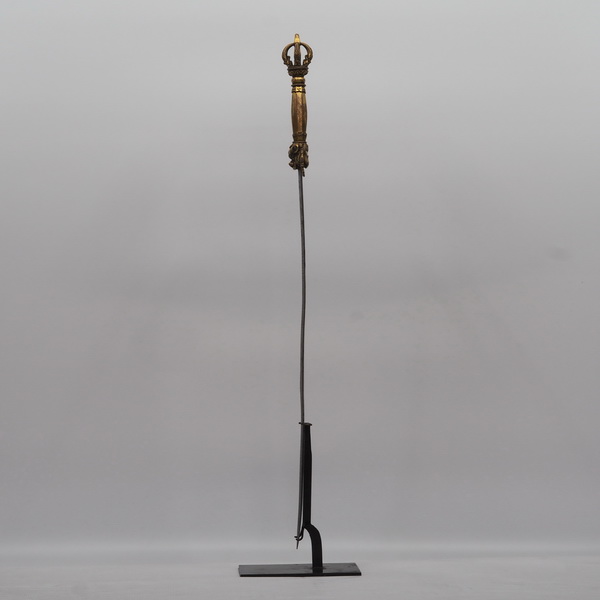ABR 048
Code: ABR 048
Country: Tibet
Style: Nepalese School
Date: 1600 - 1700
Dimensions in cm WxHxD: 7 x 54
Materials: Iron, gilt copper and gold
Sword
The sword of wisdom and discriminating awareness which cuts through the veils of delusion, is an emblem of Manjushri who raises it with his right hand. With his human manifestations (Trisong Detsen, Sakya Pandita, Tsongkhapa, and Longchenpa), the sword rests on a lotus flower.
The end of the handle is formed by a vajra, the prongs of which are disgorged by macaras (mythical creatures). The transition between handle and blade is formed by Kirtimukha (and not, as in the description in the catalogue, Garuda). The Nepalese origin of the weapon can be deduced from the inscriptions on both sides of the blade. Golden mantras in honor of the tutelary deity Mahakala adorn the blade on both sides.
Kirtimukha was originally an emanation of the demon Rahu in the form of a lion. He was sent out by king Jalandhara to challenge Shiva over his companion Parvati. But Shiva overcame the demon and transformed him into a weak starving lion. Rahu surrendered, and in his hunger he had to devour himself. When only the head was left, Shiva gave him the name "Glorious Face". Thus Kirtimukha became the emblem of Shivahimself and from now on adorned the archways of temples dedicated to him. In Tibet, it is frequently used as a decorative motif on pillars or lintels; it is also seen as a door knocker.
The sword of wisdom and discriminating awareness which cuts through the veils of delusion, is an emblem of Manjushri who raises it with his right hand. With his human manifestations (Trisong Detsen, Sakya Pandita, Tsongkhapa, and Longchenpa), the sword rests on a lotus flower.
The end of the handle is formed by a vajra, the prongs of which are disgorged by macaras (mythical creatures). The transition between handle and blade is formed by Kirtimukha (and not, as in the description in the catalogue, Garuda). The Nepalese origin of the weapon can be deduced from the inscriptions on both sides of the blade. Golden mantras in honor of the tutelary deity Mahakala adorn the blade on both sides.
Kirtimukha was originally an emanation of the demon Rahu in the form of a lion. He was sent out by king Jalandhara to challenge Shiva over his companion Parvati. But Shiva overcame the demon and transformed him into a weak starving lion. Rahu surrendered, and in his hunger he had to devour himself. When only the head was left, Shiva gave him the name "Glorious Face". Thus Kirtimukha became the emblem of Shivahimself and from now on adorned the archways of temples dedicated to him. In Tibet, it is frequently used as a decorative motif on pillars or lintels; it is also seen as a door knocker.






